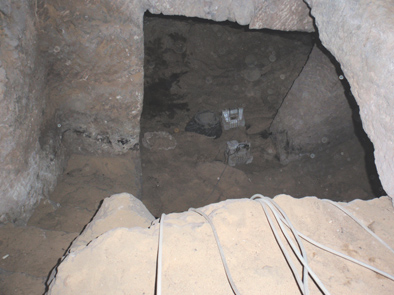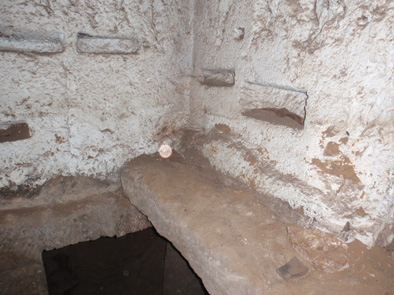![]()
![]()
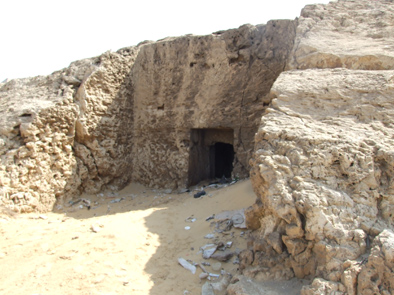
Giza
tomb NC2 at the center of the cave debate
EXPLORATION
OF GIZA CAVE TOMB
STEPS UP A GEAR
Experts
in Different Fields Called in
to Examine Egypt's Lost Labyrinth
News Story by Andrew Collins
Wednesday,
3 February 2010. Cairo: Work at the enigmatic tomb concealing the hidden entrance
to Giza's lost cave world has stepped up a gear as Dr Zahi Hawass, Secretary General
of Egypt's Supreme Council of Antiquities, reveals that the mysterious location
is being probed by a host of experts.
"We have experts in all fields working with us," he revealed this week. "Archaeologists, geologists, engineers, and architects, to name a few."
Dr Hawass is, however, being tight lipped on exactly why there is so much interest in the tomb, designated "NC2" by American Egyptologist George A. Reisner (although renamed by us the "Tomb of the Birds" due to its ancient, albeit secondary, usage as a bird cemetery - see below).
"I will be posting information about our excavation at Giza on my web site," he told me in a recent email, "and will be publishing the results of our work in due course."
Work at the cave-tomb began quietly in August last year, and has continued ever since, with two new rock-cut shafts and stairways being uncovered to date. These have been found to lead into a maze of underground chambers and galleries never before seen in modern times. Their exact age is unclear, although recently, in an email to the author, Dr Hawass strongly hinted that the tomb in fact dates to the Old kingdom period, its "catacombs", as he calls them, later being reused as a bird and animal necropolis.
Dr Hawass realised the potential significance of Giza's Tomb of the Birds following the rediscovery in its interior of a concealed entrance leading into a natural cave system. This was located by Egyptological researcher Nigel Skinner Simpson and myself in March 2008. A small breach in a stone and mud wall allowed entry into a fantastic cave world full of bats, poisonous spiders, and untouched archaeology.
To find these caves, Nigel and I explored vital clues left in the 200-year memoirs of a British diplomat named Henry Salt (1780-1827), which were published for the first time in 2007.
Despite Dr Hawass admitting that experts are now helping in the investigation of Giza's cave-tomb, the world's most famous Egyptologist will not be drawn into debate on the existence of what he refers to as "Collins' caves".
On a prestigious online Egyptological forum that has been following the story, I recently wrote: "Dr Hawass has said that there are no natural caves at the site, simply a pharaonic tomb later reused as catacombs. This is despite a wealth of evidence, including various published photos, that suggest differently."
The forum, which is subscribed to by some of the world's top Egyptologists, had been debating the topic of the caves, suggesting, quite wrongly, that American Egyptologist Dr Mark Lehner might have been shown exploring them in a documentary entitled "Mysteries of the Pyramids ... Live", first screened in 1988 with Egyptian actor Omar Sharif as narrator. However, after some diligent checking by myself and Nigel Skinner Simpson, it was determined that Lehner is actually shown in a montage of underground locations at Giza, as well as in the so-called Osiris Shaft beneath the Second Pyramid's causeway (even though this sequence was cut from the version of the documentary afterwards put on general release), and even in a tomb at Saqqara (despite the fact that Saqqara fails to get a mention in the documentary). Nowhere is Lehner shown in either the Tomb of the Birds, or its associated cave system.
Our rediscovery of Giza's cave underworld, and the amazing research that led to its rediscovery, is detailed in my book Beneath the Pyramids (4th Millennium Press), available by clicking here.
![]()
WHAT
IS HAWASS'S TEAM DOING AT THE TOMB?
WHAT
HAVE THEY UNCOVERED?
Andrew
Collins Reports
What
exactly is going on at the Tomb of the Birds (NC2), in the north cliff of Giza's
famous plateau? Since its clearance began in August 2009, three separate parties
are known to have gained acess to the rock-cut sepulchre. The images reveal much
about just how much Hawass's team have achieved in such a short space of time.
Read the full picture story below to gain a fascinating insight into the recent
developments at the Tomb of the Birds.
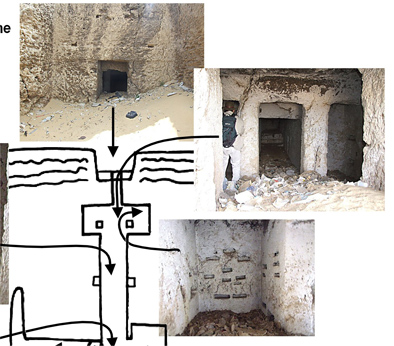 | On the left you can see a section of the overhead plan of the tomb # NC2 drawn by myself following our own visits in January 2007, and March and April 2008. Three photos show the height of the sand filling the tomb's interior and exterior area. You can also see the letter box like niches in the east wall of the east lobe of the structure's T-shaped anteroom. These we think were used to deposit bird mummies as well as small mummified animals, such as shrews, rats and snakes, given as offerings to a local bird deity attached to the tomb and caves. |
Another shot of the east lobe shaft, this one taken by alternative Egyptology researcher Larry Hunter on November 5th, 2009 (PB050955). It shows multiple power cords descending into the hole, indicating that a considerable amount of activity is taking place inside the galleries. Note that we see here two openings at the base of the shaft, one going southwards and the other eastwards. Both lead into a series of newly revealed chambers and compartments. Pic credit: Larry Hunter, 2010. |
Another one of Larry Hunter's shots of the east lobe (PB050956), this one showing the size of the letter box niches, one of which, on the right, contains a pick axe head. Clearly the mummified remains of a fairly large bird or animal could have been deposited in this hole. Pic credit: Larry Hunter, 2010. |
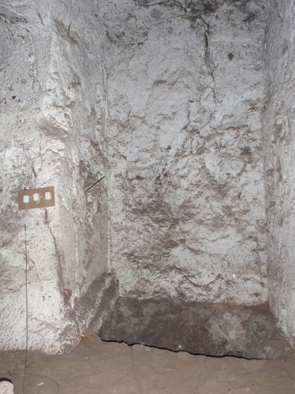 | Left, a shot of the west lobe (PB050957)taken by Larry Hunter on his visit to the Tomb of the Birds on November 5th, 2009. We see the vertical shaft down to the subterranean galleries, although the descending staircase is out of sight. Note the extension lead and plug sockets affixed to the wall, with one lead trailing down into the hole. Pic credit: Larry Hunter, 2010. |
Perring confirmed the tomb's avian association by labelling it: "EXCAVATED TOMBS AND PITS OF BIRD MUMMIES" in a plan he did for Vyse's three volume work entitled "Operations Carried On At Gizeh", published 1840/1842. As you can see from this section of the plan, some attempt has been made to represent the tomb's subterranean galleries, which are shown going into the bedrock for anything up to 50 metres distance. | The "Tomb of the Birds", as we refer to it, appears also on another Perring plan, a section of which is shown above. It was included in Perring's book "The Pyramids of Gizeh from Actual Survey and Admeasurement", published in three volumes between 1839-42. Here the same legend appears alongside the tomb, which is now shown in greater detail. A more accurate attempt has been made to convey the extent of the subterranean galleries explored by Vyse and Perring in 1837. Clearly these subterranean structures are the same as those uncovered by Dr Hawass since his work began at the site in August 2009. The exact layout of these galleries remains unclear. However, I have it on good authority from Larry Hunter that they extend into the bedrock for a distance of "at least 50 yards", making sense of Perring's plans, which are respected in the Egyptological community for their accuracy. |
One question that has been put to me is whether or not the tomb's subterranean galleries, first located by Vyse and Perring in 1837, break through into the natural cave system, accessed via a different part of the tomb. The answer seemingly is that the compartments and chambers reached via the shaft and staircase in the tomb's west lobe do penetrate into unhewn areas of the bedrock, which might well allow access to the natural caves. This surmise makes sense as the cave system is located beyond the southwest corner of the tomb, and at a depth comparable to the rock-cut catacombs accessed via the staircase in the tomb's west lobe.
In conclusion, it is now our opinion that Vyse and Perring explored the subterranean galleries of Giza # NC2, our "Tomb of the Birds". On the other hand, there is very little evidence to suggest that Henry Salt and his Italian accomplice Giovanni Caviglia explored the same set of galleries. Salt's memoirs seem to indicate that the two men investigated the cave system only, and this for an estimated distance of "several hundred yards", a much greater distance than the suggested "50 yard" extent of the subterranean galleries. Yet in the same manner, it now appears that Vyse and Perring did NOT explore the natural caves, even though I suspect its opening chamber, located at the southwest corner of the tomb, appears on Perring's more detailed plan, drawn sometime between 1839-42. My colleague Nigel Skinner-Simpson is, however, of the opinion that Perring's plan does NOT show the cave's opening chamber, "the Dome" as we call it. In his opinion the large rectangular chamber is located at the southern end of the underground galleries currently being explored by Hawass and his team, and has no direct connection to the natural caves. We will agree to differ on this point until further information is available to resolve it one way or the other.
Strangely, the preliminary plans of the Tomb of the Birds drawn by Reisner's team in 1939 suggest that he too was unaware of the subterranean galleries, and, for whatever reason, did not record the natural cave system. These are oversights that we can only put down to his list of priorities elsewhere on the plateau as the imminent threat of the World War Two loomed ever nearer.
As
we are allowed to publish more photos from excursions into the tomb, subterranean
galleries and caves, I shall try and update this article, bringing you the very
latest developments in this fascinating mystery of our times.
See
Andrew Collins and his team's rediscovery of Giza's cave underworld in 2008 on
YouTube by clicking here
For a comprehensive introduction to Andrew Collins's book Beneath the Pyramids, which features the quest behind the discovery of Egypt's cave underworld, click here To
buy BENEATH THE PYRAMIDS, Andrew's new book on the quest to find Giza's cave underworld,
from Amazon click here. |
![]()
